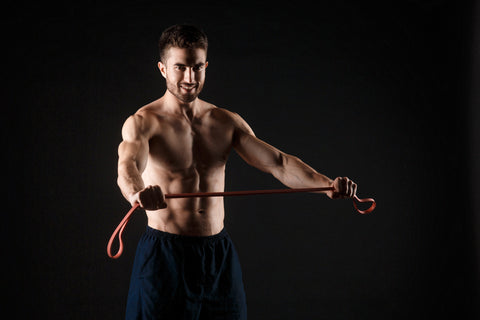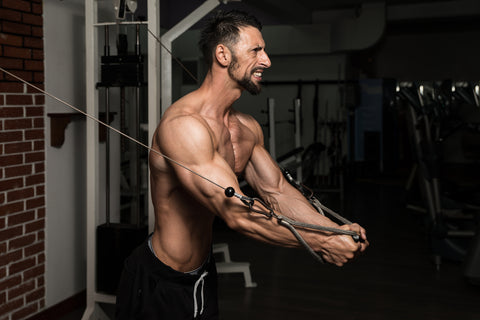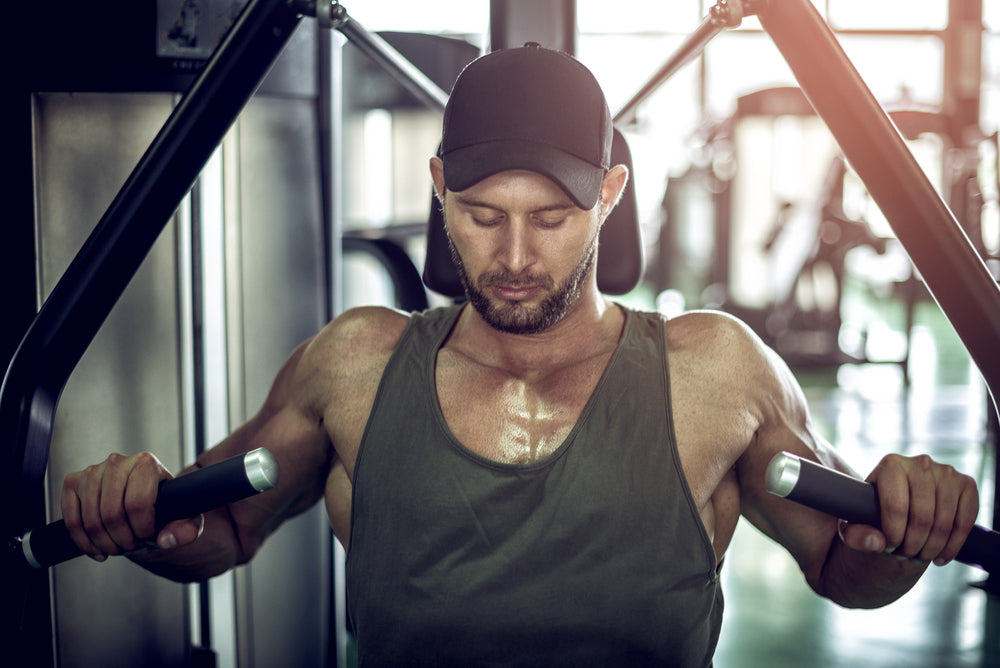

FREE SHIPPING AT $150
YOU'VE EARNED FREE SHIPPING!
FREE SHIPPING AT $150
YOU'VE EARNED FREE SHIPPING!
April 12, 2021 9 min read
When it comes to strength training, a lot of people will get involved in it because they want to build up their chest, core, and arms. Whether you are a newbie or a long-time fitness enthusiast, you probably think of a bench press with dumbbells or a barbell first when you hear strength training or weightlifting.
Seeing as how lifting weights is an incredible way to build muscle fast, this does not come as a surprise. But what are you to do if you do not have access to a gym or a workout bench at home? That’s where the standing chest press comes in to save the day.
In fact, the standing chest press will work a lot of the same muscles as a bench press, but in different ways. Let’s discuss the difference between the two before we dive into how to do a standing chest press.

Though the bench press and chest press both target your pectoral muscles, they each have their pros and cons. For starters, the bench press will improve your range of motion better than a chest press will.
Additionally, there are no cables involved to restrict your movement thus forcing the body to use more muscle fibers and activate more stabilizers; smaller muscles the body “recruits” to help keep the weight steady throughout the movement such as the rotator cuff, rhomboids, pectoralis minor, and erector spinae.
Lastly, the bench press requires a spotter and a weight bench. If you do not have either of these things, you will have to get creative with your workout routines in order to still build up your strength. Luckily, a standing chest press does not require the use of a bench or a spotter.
On top of that, you may be using a machine with cables or pulleys to execute your standing chest press which means you are performing the movement on a fixed-line. Due to the fixed-line movement, you are at less risk of injury. In addition, learning the proper form and technique for a chest press is much easier than a bench press. Also, unlike a barbell, you can perform a standing chest press using one arm at a time to maximize your strength in different ways.
One of the best ways to prevent serious injury during your workout sessions is to use proper form when performing the exercises. To do so, you need to keep your mind aware of what your body is doing.
This sounds harder than you think. Imagine your body as a straight line by keeping your core engaged, hips tucked, feet planted, and relaxed shoulders. Keeping good form will help you perform the movement correctly and prevent overextension.
Now that we understand the difference, let’s get to the good stuff. How the heck do you do a chest press? It’s actually pretty simple. While performing a standing chest press, you will mostly target your pecs and shoulders, but also your biceps, triceps, back muscles, and abdomen. An important thing to note about the standing chest press is it can be performed with or without a machine.
If you are at the gym, we recommend using the actual machine for this. To perform a standing chest press with the machine, begin by grabbing the pulleys and standing as the instructions on the machine state to do. Keep your elbows bent and lean forward slightly. Take a deep breath in and press the handles forward until your arms are fully extended in front of you.
Exhale as you bend the elbows to bring the handles back to the starting position. You can choose to do both arms at the same time, or you can alternate arms to work different stabilizers. If you are doing your workout from home or outside, you can still execute a standing chest press. All you need is strength, endurance, and a set of dumbbells.
To begin, pick up one dumbbell and hold it pulled in towards your center, meaning the elbows should be bent. Depending on your fitness goals, you can hold the dumbbell horizontally with a hand on each end of it or you can hold the dumbbell vertically by grabbing one end with both hands. Keeping the dumbbell centered, stand with your feet shoulder-width apart.
Next, engage your arms and push the dumbbell forward until your arms are straight in front of you. Then simply return to the starting position. You can advance the exercise by completing the movement with one arm at a time. Another option is to use resistance bands or tubing. This will provide a similar effect as if you were to use the chest press machine at the gym.

To use a resistance band, simply replace the dumbbells with the resistance band. The band should be hooked or stabilized by something such as a bar or a door frame. Grab the resistance bands from behind you and lean forward slightly. Just like the other standing chest press options, you can perform this move with a single arm and switch to the opposite side or you can pull the bands forward with both arms at the same time.
Regardless of how you choose to execute the standing chest press, always focus on your breathing. Remember to inhale when you are pushing out and to exhale when bringing it all back in. This will help the much-needed oxygen get to your muscles properly and increase blood flow. Oxygen is essentially fuel for the body, meaning we need a lot of it, especially when we are working out because this causes the body to go through its oxygen supply faster.
Please note: It is normal to feel out of breath while exercising. However, it should not leave you gasping for air. If this occurs, you should seek medical attention to rule out or diagnose any serious health conditions.
In order to build up your chest, you will need to perform more than just standing chest presses. To help you see the results you are looking for, here are some additional standing chest exercises you can add to your next upper-body workout session.
This exercise will require dumbbells. Begin with the dumbbells at your sides, palms forward, and feet shoulder-width apart. Slightly bend the knees and engage your core to lift your arms upward bringing the dumbbells to meet at chest height.
Keep the movement slow and steady as you return to the starting position, dumbbells at your side. That is one rep. Be aware of your momentum to be sure you are not swinging the weights instead of lifting them.
This exercise will require resistance bands or tubing. Before starting, ensure the bands or tubing is secure. Once they are secure, stand with your back towards the bands. Grab a band with each hand. Place your arms straight out from your sides, as if you are flying. Now, take a step forward with your right leg as you bring the bands around in front of you.
Your arms should now be straight out in front of you. Step back and return to the starting position. As you complete your rep count for your set, you can choose to alternate the leg you step forward or focus on one leg for each set.
The Svend Press will require dumbbells to execute. Stand with your feet hip-width apart and relax your shoulders. Grip the dumbbells with your palms down, one in each hand. Begin in the starting position by bending at the elbow, lower the dumbbells towards the floor until your arms are parallel to the ground.
Now continue to extend the dumbbells out until your arms are straight and then return to the starting position. If you want more of a challenge, try increasing the speed at which you move between reps or use heavier weights.

This exercise can be completed using a machine at the gym or resistance bands. Begin with the cables behind you, one each hand with your arm in the air above your head. Now engage your arms and core to bring your arms into an “X” in the front of your body. Return your arms overhead. That is one rep.
This exercise can be modified by adjusting the position of the cables. To target your lower chest muscles, placing the cables near the floor will work best. This is sometimes referred to as a low cable crossover. You will want to do the opposite if your focus is on the upper chest muscles, which is known as a high cable crossover.
This exercise will require dumbbells, as the name implies. This is a great choice for beginners as it works your chest, arms, and shoulders while being easy to complete. Begin with your feet shoulder-width apart, a slight bend in the knees, and a dumbbell in each hand with your palms facing down.
To start the movement, the dumbbells will rest in front of your thighs. Next, lift your arms up and out until your arms are fully extended and in line with your shoulders. Pause for a breath before slowly lowering your arms until you reach the starting position.
As the name hints, this exercise will also require a set of dumbbells. Hold a dumbbell in each hand with your feet shoulder-width apart and weights by your sides. This is your starting position. Next, engage your arm muscles and pecs to lift the dumbbells up in front of you until they are at chest level.
Continue the motion by moving your arms backward and out (as if you are showing off your wings) before returning back to the starting position. This is another exercise you can choose to do simultaneously with both arms or alternate sides. It all depends on your fitness goals.
You may be wondering why so many people use a weight bench when working out when you can work similar muscle groups without the machines and gym equipment. It is likely that they may not be aware of other options.
Next time your gym buddy wants to focus on their upper body, tell them about the following benefits of choosing a standing workout instead:
Essentially, when it comes to any exercise, one of your top priorities should be to do everything you can to prevent injury. This can be as simple as using a spotter (especially if you are a novice) or it can be a bit more complicated such as ensuring you rotate your workouts to target different muscle groups.
If any of the movements you are doing are causing you pain or stress, you should adjust accordingly to avoid overtraining. Some additional ways to prevent injury include doing a quick warm-up and cool down.
Taking 5-10 minutes to partake in a quick jog or a couple of sets of jumping jacks and high knees will loosen your muscles allowing them to perform better. When it comes to a cool down, focus on stretching the muscle groups you worked most to prevent Delayed-Onset Muscle Soreness (DOMS).
In our short time together, we learned a lot about the standing chest press including the many benefits. Known as being extremely safe to use, the standing cable chest press is great for fitness novices and veterans alike.
They are great for those who prefer to work out at home, if you don’t have a weight bench, or if you feel like taking your workout outside. Take your pecs, arms, and core to the next level using standing exercises as opposed to always deferring to a bench press or a push-up and don't forget to load up on some fantastic supplements while you're at it!
